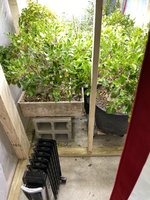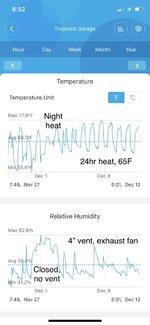hemmy
Omono
I’m looking for recommendations on venting and any other improvements for a large tropical tent in the attached unheated garage. With prolonged nighttime lows into the low 20sF, the garage has seen mid-40s. I still have a few gaps and attic access to close which may help for a Arctic blasts we might get.
Trees are mostly ficus, a bougainvillea, and some Portulacaria. I’ve been slowly improving the tropical area with more light, enclosing, heat, and fans. I believe the temperature goal is tied to the available light and growth. I don’t have a real light meter. But there are three SpiderFarmer SE3000 (LED 300W) lights. Each has a 3x3ft footprint, which I’m stretching with a 5’Wx8’Lx7’H enclosure. I still could improve the light with some type of reflective material on the walls. Given my lights, I think I can get decent growth at ~75F day (12hrs light) with low 60sF night.
But first on ventilation, I’ve had it enclosed with 4mil flame retardant plastic for a month with one end open where I blew heat in from an electric oil heater at night. Now that we are getting colder out, I’ve extended the framed tent to have an extra 2’ so the oil heater is in the tent and fans at the top circulate the air (one oscillating above the heater and another pushing air down the tent). A future step might be to seal off the heater space and use a top vent with fan to bring the air into the plant tent (a lung room). Is that better for the life of the heater (lower humidity) and less dry heat for the plants adjacent to the heater?
My current need is to add 2 vents to draw air and possibly exhaust fans to control humidity and ambient CO2. The tent with heater enclosed space is 350 cuft. The larger oscillating fan is 1300-1600 cfm and the 6” clip on fan is 190 cfm. From the online resources, a source advises replacing the volume of air every 2-3 minutes. Using an online calculator with approximate modifiers for insulation, LED lights, temperature of intake, etc, (https://www.omnihomeideas.com/patio-lawn-garden/grow-tent-room-cfm-calculator/); gives me the need for 108cfm exhaust and 92cfm intake fans to replace the air every 3 minutes. Every 3 mins seems excessive, but most smaller fans look to be in the 100cfm anyway.
Does anyone have recommendations for air replacement, fan cfm, active/passive ventilation, etc. for tropical bonsai?
Tonight, I’ll add a top 4” vent hole to the opposite end from the heat side and a 6” bottom hole near the heater. Depending on humidity levels, I’ll look to add 4-6” exhaust fan at top vent. Thoughts @cmeg1 ?
Any tips, recommendations, or criticisms are welcome.
Trees are mostly ficus, a bougainvillea, and some Portulacaria. I’ve been slowly improving the tropical area with more light, enclosing, heat, and fans. I believe the temperature goal is tied to the available light and growth. I don’t have a real light meter. But there are three SpiderFarmer SE3000 (LED 300W) lights. Each has a 3x3ft footprint, which I’m stretching with a 5’Wx8’Lx7’H enclosure. I still could improve the light with some type of reflective material on the walls. Given my lights, I think I can get decent growth at ~75F day (12hrs light) with low 60sF night.
But first on ventilation, I’ve had it enclosed with 4mil flame retardant plastic for a month with one end open where I blew heat in from an electric oil heater at night. Now that we are getting colder out, I’ve extended the framed tent to have an extra 2’ so the oil heater is in the tent and fans at the top circulate the air (one oscillating above the heater and another pushing air down the tent). A future step might be to seal off the heater space and use a top vent with fan to bring the air into the plant tent (a lung room). Is that better for the life of the heater (lower humidity) and less dry heat for the plants adjacent to the heater?
My current need is to add 2 vents to draw air and possibly exhaust fans to control humidity and ambient CO2. The tent with heater enclosed space is 350 cuft. The larger oscillating fan is 1300-1600 cfm and the 6” clip on fan is 190 cfm. From the online resources, a source advises replacing the volume of air every 2-3 minutes. Using an online calculator with approximate modifiers for insulation, LED lights, temperature of intake, etc, (https://www.omnihomeideas.com/patio-lawn-garden/grow-tent-room-cfm-calculator/); gives me the need for 108cfm exhaust and 92cfm intake fans to replace the air every 3 minutes. Every 3 mins seems excessive, but most smaller fans look to be in the 100cfm anyway.
Does anyone have recommendations for air replacement, fan cfm, active/passive ventilation, etc. for tropical bonsai?
Tonight, I’ll add a top 4” vent hole to the opposite end from the heat side and a 6” bottom hole near the heater. Depending on humidity levels, I’ll look to add 4-6” exhaust fan at top vent. Thoughts @cmeg1 ?
Any tips, recommendations, or criticisms are welcome.








